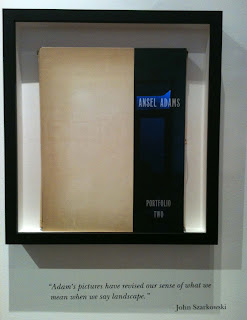This morning I woke up with a ravenous soul. The weekend promised a much-needed respite from both the excitement and the drain of spring's rambunctious pace.
I knew exactly what I craved to replenish my inner well: the rich deliciousness of photography. I hungered for texture. For the rhythm of a substance, the flow and dance that all the materials in this world hold when we take the time to stop and look.
After this outward, social, breakneck week I was ready stop and look, and let art's vision fill the hollows in my heart, the welcoming warm space throbbing in my chest.
I looked over gallery listings as I took care of my empty tummy. I'd read about an exhibit of Ansel Adams' work in conjunction with Sierra Club at G2 Gallery months ago, and though I have a date with my dad for a Venice art adventure on the closing weekend of the show, I headed over to Venice.
Ansel's bespectacled face peers up at me from the cover of time magazine (September 3, 1979) in a case in the center of the warm upstairs gallery space that also holds his first Kodak Brownie.
The photos are mostly from the National Parks, and the original 1950 Portfolio Two stands like a monolith in a shadowbox in a corner of the gallery. That goofy smiling image seemed somehow at odds with the resonant black and white forms, the silent landmasses and snowdrifts and leaf prints ringing the room, as well as the exuberant holiness of Walt Whitman's poem* on the folio frontispiece.
You have seen these images. They are as megalithic a cultural phenomenon as the synergy of earth, air, water and light Ansel shot. And they are so humble, too. Just the play of the camera, just the result of light on coated paper, just snapshots. Just.
A picture of Schoodie Point in Maine opens to a great flat stretch of the Atlantic Ocean, articulated in the foreground by rocks below the water's surface. The water cascades from high to low, arcing over the rock, made gentle by the break in the surface level.
Were I there to study photographic technique I'd linger at the forest at Mount Rainier, a perfect composition as far as I can tell.
The texture of a jagged stump where a moth alights for a moment looks like ice floes were caught in the wood long before it split apart, cleaved maybe by the yearly sequence of freeze and thaw in Glacier Bay.
The streaked cliffs of Canyon de Chelly dwarf the millenia old dwellings niched in a pocket in the cliff face, dwarf the trees massed in the foreground. The image is called White House ruins.
Though I've become used to framing spaces like these in geologic time - a slow eroding that eludes the sense of one human's lifetime - yet what a transformation happened in my time when it became Joshua Tree National Park. This brought a ringing awareness of how conservation absolutely happens in the present tense. The whole expanse of it is there for us, for inspiration, education, and recreation.
Ansel's black and white image of the forest at dawn in the Great Smoky Mountains drains the rainbow foliage but replaces color with kinetic energy. The eye ricochets from shape to shape, alighting on one tree top after another. The tree's shapes seem sculpted by sparks, caught fire, as the sun ignites each tiny leaf. They look like bright ashes that, stilled by the camera, promise to dance down when we stop holding our breath.
Ansel talks about the genre of landscape photography in a way that preferences the individual's artistic engagement with what she sees: "a creative experience, in which the fact that it is a landscape, is incidental, perhaps accidental, and secondary in importance to the fact that...a subjective experience was created and expressed."
How lucky I am to have engaged so many of the places Ansel photographed: Sonoma County, Glacier National Park, the Snake River in the shadow of the Grand Tetons. And how proud I am to be part of the Sierra Club. There is probably not a single bone in my body that could be called political, but about the world around me and its beauty I am passionate, and that reverence for nature stirs me to action. On the most basic level, my journey has been self serving, because I love these spaces and how they nourish me. A quote at the entrance to the exhibit said much the same about Ansel: regardless of what he did for us, he did it all for himself.
I knew that today was Earth Day, but I did not realize that Earth Day is the anniversary of Ansel Adam's death, April 22, 1984**. What a beautiful memorial.
G2 Gallery
http://www.theg2gallery.com/
Sierra Club
http://www.sierraclub.org/
*Excerpted from "Starting from Paumanok" by Walt Whitman:
Each is not for its own sake,
I say the whole earth and all the stars in the sky are for religion's sake.
I say no man has ever yet been half devout enough,
None has ever yet adored or worship'd half enough,
None has begun to think how divine he himself is, and how certain the future is.
**A bit about Ansel Adams:
Born in San Francisco in 1902, Ansel chose experiential education over formal schooling, and first visited Yosemite at age 12. His amazing images served to inspire and awe with their beauty, and to gently raise awareness about conservation. His association with the Sierra Club began in 1919, and he later served 34 years on their Board of Directors. He mounted an exhibition in 1955 in collaboration with the Club, and his book Sierra Nevada: the John Muir Trail, was instrumental in moving President Roosevelt to designate King's Canyon National Park in California.



